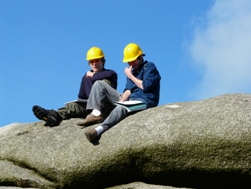
ENTHUSED
We do not know how many of the 1160 students who completed a geoscience degree in 2005 had previously taken a GCE A-level, GCSE or Scottish Intermediates or Highers in geology, and so had become enthused to take a geology degree through those routes. However, anecdotal evidence from A-level geology teachers suggests that around a third of those who complete an A-level geology examination go on to take a geoscience degree. The percentage for Scottish Higher candidates may be similar. The school exam entry figures for 2002, three years before the graduation of the 1160 students (many of whom will have taken a three-year degree) show that 1178 candidates were entered for A-level geology that year, while 49 students were entered for Scottish Higher geology. If a third of these took a geoscience-related degree, this would have been more than 400 students, or 35% of those who graduated with geoscience-related degrees in 2005.
So, if more than third of those who graduate with a geoscience-related degree come through an A-level or Scottish Higher route, and a fifth of them go on to employment as geoscientists, this suggests that A-level and Scottish Higher geology do play an important role directly in the nation’s economy. We have already made the point that the geological backgrounds of other individuals, not employed as geoscientists per se, may play an equally vital role, through their work as politicians, journalists, lawyers and so on.
For all these reasons, we believe that the health of GCSE, A-level geology and Scottish Intermediate and Higher level geology is important to UK society. Thus, it is very pleasing to report that, after some years of stagnation or even decline, all geology GCSE, AS-level and A-level examination entries increased last year (Table 1, Figures 1, 2 and 3). The statistics are taken from the Joint Council for Qualifications (JCQ). The increased entries cannot be explained by increases in student numbers, since according to the Office of National Statistics (ONS) there were demographic falls in the numbers of 16, 17 and 18 year-olds from 2009 to 2010 (Figure 4).